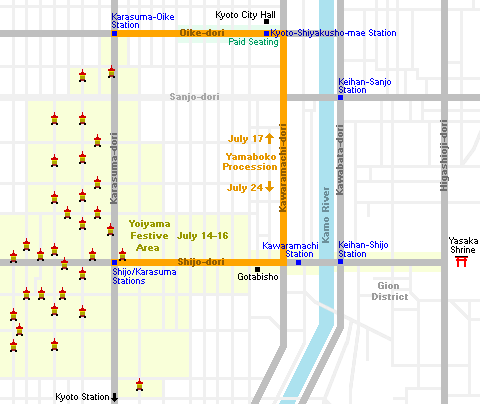Gion Matsuri
Date: 17 July and 24 July
Gion Matsuri, the festival of Yasaka Shrine, is the most famous festival in Japan. It takes place over the entire month of July. There are many different events, but the grand procession of floats (Yamaboko Junko) is particularly spectacular. Very enjoyable, are also the festive evenings preceding the procession (Yoiyama). From 2014, a second procession of floats was reintroduced on July 24 after a hiatus of 48 years. The second procession features fewer and smaller floats than the one on July 17.
Floats and History
The word Yamaboko refers to the two types of floats used in the procession: the 23 yama and 10 hoko. One of the main reasons the Gion Matsuri is so impressive is the enormity of the hoko, which are up to 25 meters tall, weigh up to 12 tons, and are pulled on wheels as big as people. Both yama and hoko are elaborately decorated and represent unique themes. The procession on July 17 features 23 yama and hoko, including most of the particularly impressive hoko, while the procession on July 24 features the remaining ten yama and hoko.
Another reason for the festival’s impressiveness is its long and almost uninterrupted history. It dates back to 869 as a religious ceremony to appease the gods during the outbreak of an epidemic. Even today, the festival continues the practice of selecting a local boy to be a divine messenger. The child cannot set foot on the ground from the 13th until after he has been paraded through town on the 17th.
Main Events
Ironically, the highlight events of Gion Matsuri do not actually take place in the Gion district, but rather on the opposite side of Kamo River. During the three days preceding the procession, the respective yama and hoko are displayed within about a half kilometer of the intersection of Karasuma and Shijo streets (see map below). While they are on display, some of the floats can be entered by tourists.
The area becomes most exciting in the evenings, when from 18:00 until 23:00, the streets are closed to traffic and the area swells with food stands, drink vendors, and other festival hallmarks. These festive evenings leading up to the procession are known as Yoiyama (July 16), Yoiyoiyama (July 15) and Yoiyoiyoiyama (July 14). Note that road closures in 2016 happen on the 15th and 16th only. Similar festivities also take place on the three evenings leading up to the procession on July 24, albeit on a smaller scale and without road closures and stands.
The processions of floats (Yamaboko Junko) take place between 9:00 and 11:30 on the 17th and 24th and follow a three kilometer long route along Shijo, Kawaramachi and Oike streets (starting from Shijo-Karasuma on the 17th and from Karasuma-Oike on the 25th). Some paid seating is provided in front of the city hall (3180 yen; advance booking required), but because the procession takes place over quite a long route and duration, good viewpoints can also be found elsewhere without too much trouble
Gion Matsuri’s other events are not quite as impressive, but also enjoyable. From July 10 to 14 (and from July 17 to 21 for the second procession), visitors can watch the assembling of the floats, which is done from scratch and without the use of nails each year. The Byobu Matsuri, which coincides with the days of Yoiyama, involves local residents opening their front doors and exhibiting family heirlooms to passersby.
The procession of mikoshi takes place from 18:00 on the 17th, starting at Yasaka Shrine and ending at the Otabisho. The event involves carrying the shrine’s deity out of the shrine grounds and through the town in a mikoshi, a portable shrine, which is set on wooden beams and carried on the shoulders of local men. On the 24th, the mikoshi is returned to the shrine.


